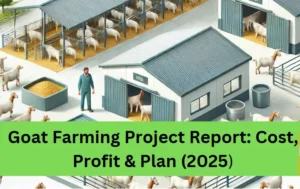Problematic Soils and Their Management MCQ

🌿 Introduction: Problematic Soils and Their Management Multiple Choice Question
Problematic soils like saline, sodic, acidic, and eroded soils affect crop productivity and soil health. Understanding their properties, causes, and management techniques is essential for sustainable farming.
This blog provides 25+ MCQs with explanations covering soil degradation, reclamation methods, soil amendments, and best agricultural practices. Perfect for agriculture students, competitive exam aspirants, and farmers looking to improve soil fertility and crop yield.
Let’s explore the key concepts of problematic soil management with in-depth MCQs! 🌾
Problematic soil MCQ PDF Download
1.Which of the following is the primary characteristic of saline soil?
A) Low pH and high aluminum toxicity
B) High electrical conductivity and excessive soluble salts
C) High organic matter and good drainage
D) Compacted structure with poor aeration
📝 Additional Information
A Horizon (Topsoil):
0–30 cm depth, dark-colored due to humus.
Contains plant roots, microbes, and nutrients.
B Horizon (Subsoil):
Accumulates clay, iron, and aluminum leached from above.
C Horizon:
Partially weathered parent rock, less biological activity.
R Horizon:
Unweathered bedrock, impenetrable by roots.
2: Which soil amendment is most effective for reclaiming sodic soil?
A) Gypsum
B) Lime
C) Urea
D) Sodium chloride
📝 Additional Information
- Option A: Gypsum → Correct Answer
Sodic soils have high sodium levels, which degrade soil structure. Gypsum (CaSO₄) replaces sodium ions with calcium, improving soil permeability and structure.
- Option B: Lime → Incorrect
Lime (CaCO₃) is used to increase soil pH, making it useful for acidic soils, not sodic soils.
- Option C: Urea → Incorrect
Urea is a nitrogen fertilizer and does not help in soil reclamation. It may increase soil salinity if overused.
- Option D: Sodium chloride → Incorrect
Adding sodium chloride (NaCl) worsens sodic soil by increasing sodium levels, further damaging soil structure.
3: What is the ideal pH range for most crops to grow optimally?
A) 3.5 – 4.5
B) 5.5 – 7.5
C) 8.5 – 10.0
D) 11.0 – 12.5
📝 Additional Information
- Option A: 3.5 – 4.5 → Incorrect
A pH this low is too acidic and leads to nutrient deficiencies, aluminum toxicity, and poor crop growth.
- Option B: 5.5 – 7.5 → Correct Answer
This range is neutral to slightly acidic, making nutrients available for most crops.
- Option C: 8.5 – 10.0 → Incorrect
This pH is common in alkaline soils, where nutrients like phosphorus and iron become unavailable to plants.
- Option D: 11.0 – 12.5 → Incorrect
A highly alkaline pH like this is rare in natural soils and unsuitable for almost all crops.
4: Which of the following is not a characteristic of acidic soil?
A) High aluminum and iron toxicity
B) Low availability of phosphorus
C) High pH with calcium carbonate presence
D) Common in high rainfall regions
📝 Additional Information
- Option A: High aluminum and iron toxicity → Correct
Acidic soils release toxic levels of aluminum and iron, harming plant roots.
- Option B: Low availability of phosphorus → Correct
Phosphorus becomes unavailable in acidic conditions, reducing crop growth.
Option C: High pH with calcium carbonate presence → Incorrect (Correct Answer)
High-pH soils with calcium carbonate are alkaline soils, not acidic soils.
- Option D: Common in high rainfall regions → Correct
Heavy rainfall leaches bases (Ca, Mg, K) from the soil, making it acidic.
5: Which method is most effective for managing saline soils?
A) Application of sulfuric acid
B) Frequent irrigation with saline water
C) Leaching with good quality water
D) Mixing more chemical fertilizers
📝 Additional Information
- Option A: Application of sulfuric acid → Incorrect
Sulfuric acid is used for alkali soil treatment, not saline soil.
- Option B: Frequent irrigation with saline water → Incorrect
Using saline water will increase soil salinity, worsening the problem.
- Option C: Leaching with good quality water → Correct Answer
Leaching dissolves and removes excess salts from the root zone, reducing salinity.
Option D: Mixing more chemical fertilizers → Incorrect
Some fertilizers add more salts, making saline conditions worse.
6: Which of the following soils is known as "black alkali soil"?
A) Saline soil
B) Sodic soil
C) Acidic soil
D) Laterite soil
📝 Additional Information
- Option A: Saline soil → Incorrect
Saline soils are white alkali soils due to visible salt deposits on the surface, not black.
- Option B: Sodic soil → Correct Answer
Sodic soils are also called black alkali soils because sodium disperses organic matter, creating a dark color on the surface.
These soils have a high sodium adsorption ratio (SAR), leading to poor soil structure and water infiltration issues.
- Option C: Acidic soil → Incorrect
Acidic soils have a low pH and are found in high-rainfall regions, but they are not black.
- Option D: Laterite soil → Incorrect
Laterite soils are red, not black, due to high iron and aluminum oxides.
7: Which problem is most commonly associated with compacted soils?
A) Excessive water retention
B) Poor root penetration and low aeration
C) High organic matter accumulation
D) Increased earthworm activity
📝 Additional Information
- Option A: Excessive water retention → Incorrect
Although compacted soils may retain water, they prevent water infiltration, leading to waterlogging rather than useful retention.
- Option B: Poor root penetration and low aeration → Correct Answer
Compacted soils have tightly packed particles, reducing air space, oxygen availability, and root growth.
Bulk density increases, making it difficult for roots to expand.
- Option C: High organic matter accumulation → Incorrect
Compacted soils restrict microbial activity, leading to low organic matter decomposition, not accumulation.
- Option D: Increased earthworm activity → Incorrect
Earthworms prefer loose, well-aerated soils and avoid compacted soils.
8: Which practice is most effective for reducing soil erosion in hilly areas?
A) Deep plowing
B) Terracing and contour farming
C) Excessive irrigation
D) Applying more chemical fertilizers
📝 Additional Information
- Option A: Deep plowing → Incorrect
Deep plowing disturbs soil structure and increases erosion risk in hilly areas.
- Option B: Terracing and contour farming → Correct Answer
Terracing reduces slope steepness, and contour farming slows down water flow, minimizing soil loss.
- Option C: Excessive irrigation → Incorrect
Excessive irrigation leads to water runoff, which worsens erosion.
- Option D: Applying more chemical fertilizers → Incorrect
Fertilizers improve plant growth but do not physically prevent soil erosion.
9: Which of the following conditions is responsible for acidic soil formation?
A) Leaching of basic cations
B) Excess sodium accumulation
C) High clay content
D) High calcium carbonate concentration
📝 Additional Information
- Option A: Leaching of basic cations → Correct Answer
Heavy rainfall leaches calcium, magnesium, and potassium, making the soil more acidic.
- Option B: Excess sodium accumulation → Incorrect
Excess sodium is a characteristic of sodic (alkali) soils, not acidic soils.
- Option C: High clay content → Incorrect
While clay influences soil texture, it does not directly cause acidity.
- Option D: High calcium carbonate concentration → Incorrect
Calcium carbonate increases alkalinity, not acidity.
Click here for General soil science MCQs
- General soil science top 25 questions
- Basic soil science top 25 questions
10: Which of the following crops is most suitable for growing in saline soils?
A) Rice
B) Sugarcane
C) Barley
D) Potato
📝 Additional Information
- Option A: Rice → Incorrect
Rice can tolerate temporary waterlogging, but it is not highly salt-tolerant.
- Option B: Sugarcane → Incorrect
Sugarcane is moderately salt-tolerant but requires good drainage to grow well.
- Option C: Barley → Correct Answer
Barley is one of the most salt-tolerant crops and can grow in high-salinity conditions.
- Option D: Potato → Incorrect
The potato is a salt-sensitive crop that struggles in saline soils.
11: Which amendment is most effective for reclaiming saline soils?
A) Lime (CaCO₃)
B) Gypsum (CaSO₄·2H₂O)
C) Organic manure
D) Sodium chloride (NaCl)
📝 Additional Information
- Option A: Lime (CaCO₃) → Incorrect
Lime is used to reduce soil acidity, not salinity.
- Option B: Gypsum (CaSO₄·2H₂O) → Correct Answer
Gypsum is the best amendment for saline soils because it replaces sodium with calcium, helping in soil structure improvement and the leaching of salts.
- Option C: Organic manure → Incorrect
Organic manure improves soil fertility but does not remove excess salts.
- Option D: Sodium chloride (NaCl) → Incorrect
Adding sodium chloride would increase soil salinity, making the problem worse.
12. Which type of soil is prone to aluminum toxicity?
A) Acidic soils
B) Sodic soils
C) Saline soils
D) Peaty soils
📝 Additional Information
- Option A: Acidic soils → Correct Answer
In acidic soils (pH below 5.5), aluminum becomes soluble and toxic to plants.
- Option B: Sodic soils → Incorrect
Sodic soils have high sodium, not aluminum toxicity.
- Option C: Saline soils → Incorrect
Saline soils have high salt content but not toxic levels of aluminum.
- Option D: Peaty soils → Incorrect
Peaty soils are rich in organic matter and are not prone to aluminum toxicity.
13. Which soil conservation method is best suited for dryland farming?
A) Flood irrigation
B) Mulching
C) Excessive plowing
D) Monocropping
📝 Additional Information
- Option A: Flood irrigation → Incorrect
Flood irrigation wastes water and is not suitable for dryland farming.
- Option B: Mulching → Correct Answer
Mulching reduces evaporation, conserves moisture, and controls weeds, making it ideal for drylands.
- Option C: Excessive plowing → Incorrect
Excessive plowing causes soil erosion and moisture loss.
- Option D: Monocropping → Incorrect
Monocropping depletes nutrients and is not good for soil conservation.
14: Which factor mainly contributes to soil salinization?
A) High rainfall and leaching
B) Excessive irrigation and poor drainage
C) High organic matter content
D) Low temperature
📝 Additional Information
- Option A: High rainfall and leaching → Incorrect
High rainfall washes away salts, preventing salinization.
- Option B: Excessive irrigation and poor drainage → Correct Answer
Over-irrigation and water stagnation lead to salt accumulation, increasing salinity.
- Option C: High organic matter content → Incorrect
Organic matter improves soil fertility, not salinity.
- Option D: Low temperature → Incorrect
Temperature does not directly cause salinization.
15: What is the main reason for poor fertility in laterite soils?
A) High moisture retention
B) Low organic matter and nutrient leaching
C) Excessive nitrogen content
D) High pH levels
📝 Additional Information
- Option A: High moisture retention → Incorrect
Laterite soils drain water quickly, so they do not retain moisture well.
- Option B: Low organic matter and nutrient leaching → Correct Answer
Laterite soils form in high-rainfall regions, causing nutrient leaching and poor fertility.
- Option C: Excessive nitrogen content → Incorrect
Laterite soils have low nitrogen levels.
- Option D: High pH levels → Incorrect
Laterite soils are acidic, not alkaline.
Upcoming agriculture job 2025
16: Which soil type has a high water-holding capacity but poor drainage?
A) Sandy soil
B) Clayey soil
C) Loamy soil
D) Peaty soil
📝 Additional Information
- Option A: Sandy soil → Incorrect
Sandy soil drains quickly and has low water retention.
- Option B: Clayey soil → Correct Answer
Clayey soils hold water for long periods but drain poorly, leading to waterlogging.
- Option C: Loamy soil → Incorrect
Loamy soil has balanced water retention and drainage.
- Option D: Peaty soil → Incorrect
Peaty soils hold moisture but are not common for agriculture.
17. Which crop is most suitable for growing in sodic (alkali) soils?
A) Paddy (Rice)
B) Wheat
C) Groundnut
D) Cotton
📝 Additional Information
- Option A: Paddy (Rice) → Correct Answer
Paddy (rice) can tolerate sodic soils because it is grown under flooded conditions, which help leach out excess sodium.
- Option B: Wheat → Incorrect
Wheat is sensitive to high sodium and does not grow well in sodic soils.
- Option C: Groundnut → Incorrect
Groundnut requires well-drained, neutral soils and is not suited for sodic conditions.
- Option D: Cotton → Incorrect
Cotton can tolerate some salinity, but it does not thrive in sodic soils.
Click here for General soil science MCQs
- General soil science top 25 questions
- Basic soil science top 25 questions
18: What is the main reason for soil acidity in tropical regions?
A) Excess application of lime
B) Heavy rainfall and leaching
C) High salt concentration
D) Waterlogging
📝 Additional Information
- Option A: Excess application of lime → Incorrect
Lime is used to reduce soil acidity, not cause it.
- Option B: Heavy rainfall and leaching → Correct Answer
In tropical regions, high rainfall leaches away basic nutrients (calcium and magnesium), making soils acidic.
- Option C: High salt concentration → Incorrect
High salt concentration is linked to saline soils, not acidic soils.
- Option D: Waterlogging → Incorrect
Waterlogging reduces oxygen availability but does not directly cause soil acidity.
19: Which of the following is the best method to reclaim acidic soils?
A) Adding elemental sulfur
B) Applying gypsum
C) Using lime (Calcium carbonate)
D) Leaching with water
📝 Additional Information
- Option A: Adding elemental sulfur → Incorrect
Elemental sulfur is used to increase soil acidity, not reduce it.
- Option B: Applying gypsum → Incorrect
Gypsum is used for sodic soil reclamation, not acidic soils.
- Option C: Using lime (Calcium carbonate) → Correct Answer
Lime neutralizes soil acidity by increasing pH and improving soil fertility.
- Option D: Leaching with water → Incorrect
Leaching helps remove salts but does not correct soil acidity.
20: What is the major cause of soil compaction in agricultural fields?
A) Heavy rainfall
B) Overuse of chemical fertilizers
C) Repeated use of heavy machinery
D) Low organic matter
📝 Additional Information
- Option A: Heavy rainfall → Incorrect
Rainfall does not directly cause compaction, though it can contribute by washing away topsoil.
- Option B: Overuse of chemical fertilizers → Incorrect
Chemical fertilizers affect soil fertility, but they do not cause compaction directly.
- Option C: Repeated use of heavy machinery → Correct Answer
Tractors and other heavy machines compress the soil particles, reducing air spaces and water infiltration.
- Option D: Low organic matter → Partially Correct but Not the Main Cause
Low organic matter makes soil prone to compaction, but the main reason is heavy machinery.
21. Which of the following soil types is characterized by high levels of exchangeable sodium?
A) Saline soil
B) Sodic soil
C) Acidic soil
D) Compact soil
📝 Additional Information
- Option A: Saline soil → Incorrect
Saline soils have high levels of soluble salts (NaCl, CaCl₂, MgSO₄) but not excessive exchangeable sodium.
Option B: Sodic soil → Correct Answer
Sodic soils have a high exchangeable sodium percentage (ESP > 15%), affecting soil structure and water infiltration.
- Option C: Acidic soil → Incorrect
Acidic soils have a low pH due to the leaching of basic cations (Ca²⁺, Mg²⁺) but do not have excess sodium.
- Option D: Compact soil → Incorrect
Compact soil has low porosity and poor aeration but is not directly linked to sodium levels.
22: Which of the following amendments is most effective for reclaiming saline soils?
A) Gypsum
B) Lime
C) Elemental sulfur
D) Leaching with good-quality water
📝 Additional Information
- Option A: Gypsum → Incorrect
Gypsum is used to reclaim sodic soils by replacing sodium with calcium but is not the primary amendment for saline soils.
- Option B: Lime → Incorrect
Lime is used for neutralizing acidic soils, not for saline soil reclamation.
- Option C: Elemental sulfur → Incorrect
Elemental sulfur lowers soil pH but does not directly remove salts from saline soils.
- Option D: Leaching with good-quality water → Correct Answer
Flushing excess salts with good-quality water is the most effective method to reclaim saline soils.
23: Which type of problematic soil has poor structure due to high clay content?
A) Saline soil
B) Sandy soil
C) Vertisoles
D) Peaty soil
📝 Additional Information
- Option A: Saline soil → Incorrect
Saline soils contain excess salts but may have a range of textures.
- Option B: Sandy soil → Incorrect
Sandy soil has low clay content and does not have a poor structure.
- Option C: Vertisols (Black cotton soil) → Correct Answer
Vertisols have high clay content, causing cracks in dry conditions and swelling when wet.
- Option D: Peaty soil → Incorrect
Peaty soils are rich in organic matter and are found in wetlands.
24: Which of the following factors primarily causes soil erosion?
A) Low organic matter
B) Deforestation and improper land use
C) High soil fertility
D) Presence of earthworms
📝 Additional Information
- Option A: Low organic matter → Partially correct
Low organic matter reduces soil binding capacity, but erosion is mainly caused by external factors like wind and water.
- Option B: Deforestation and improper land use → Correct Answer
Cutting trees and overgrazing expose soil to wind and water, leading to erosion.
- Option C: High soil fertility → Incorrect
High fertility does not cause erosion; it helps plants grow and stabilizes soil.
- Option D: Presence of earthworms → Incorrect
Earthworms improve soil aeration and structure, preventing erosion.
25: Which of the following is a common indicator of waterlogged soil?
A) High earthworm population
B) Reddish-brown soil color due to iron oxidation
C) Anaerobic conditions and foul smell
D) Increased soil porosity
📝 Additional Information
- Option A: High earthworm population → Incorrect
Earthworms need oxygen, and their population decreases in waterlogged conditions.
- Option B: Reddish-brown soil color due to iron oxidation → Incorrect
This color is seen in well-aerated soils, not waterlogged soils.
- Option C: Anaerobic conditions and foul smell → Correct Answer
Waterlogged soils lack oxygen, leading to the production of gases like methane and hydrogen sulfide, causing a foul smell.
- Option D: Increased soil porosity → Incorrect
Waterlogged soils have reduced porosity due to water filling all the air spaces.
Related Post-
📋 MPPSC Food Safety Officer Syllabus 2025| Notification Out for 67 Posts
The MPPSC announced 67 vacancies for Food Safety Officers. Suppose...
Read MoreMP RHEO Notification 2025: best book, Eligibility, Exam Date & Syllabus Last Few Days Exam Strategy
If you are an agriculture or horticulture graduate looking for...
Read More🐐 Goat Farming Project Report 2025 – Practical Updates Every New Farmer Must Know (Cost, Profit Analysis)
If you’re searching for a low-investment, high-return agribusiness, goat farming...
Read More“Complete MP RAEO Syllabus 2025 | Exam Pattern & Preparation Tips”
RAEO Syllabus 2025 And All Details What is MP RAEO?...
Read More



